tow NISSAN PULSAR 1987 Owner's Manual
[x] Cancel search | Manufacturer: NISSAN, Model Year: 1987, Model line: PULSAR, Model: NISSAN PULSAR 1987Pages: 238, PDF Size: 28.91 MB
Page 143 of 238
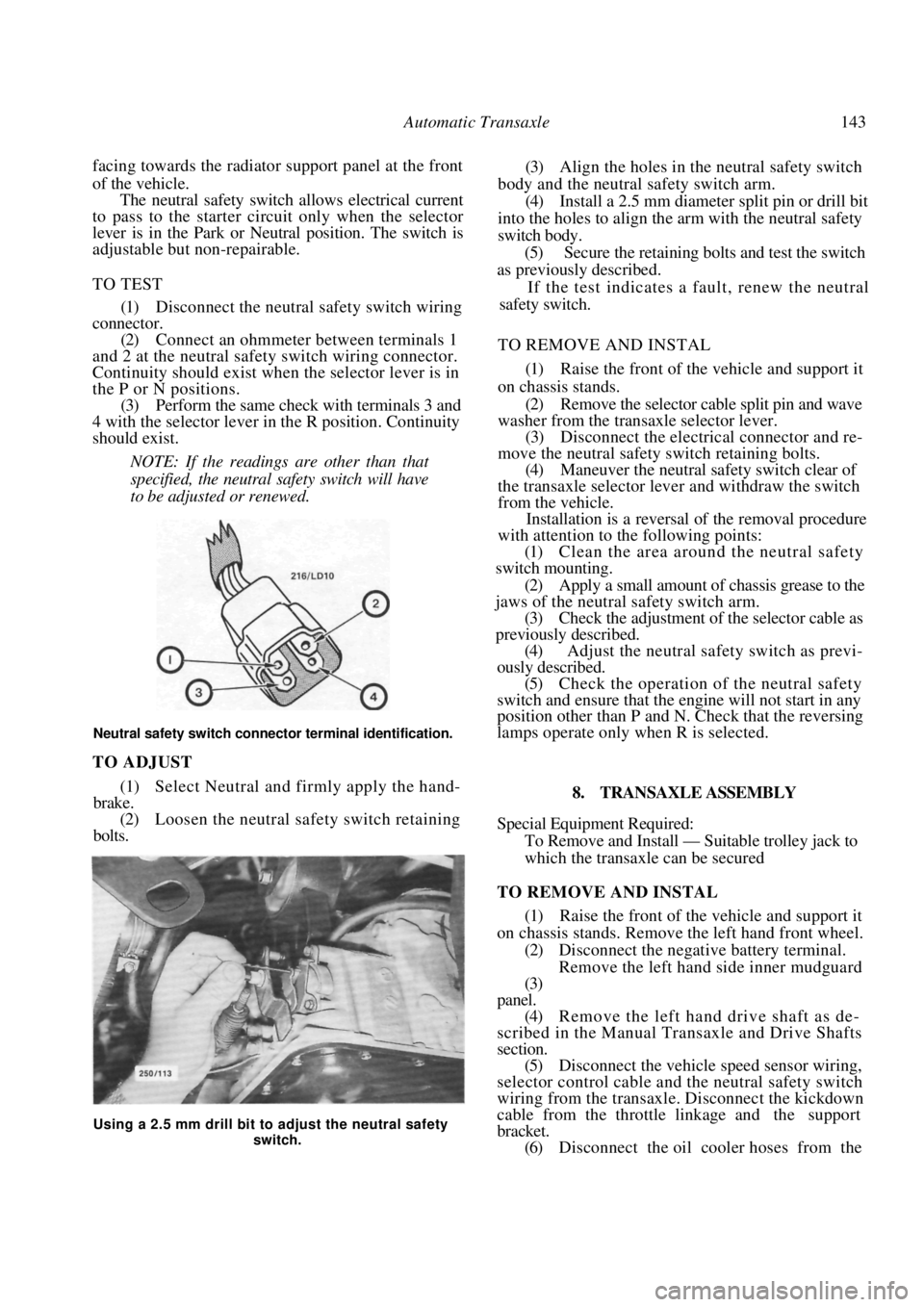
Automatic Transaxle 143
facing towards the radiator support panel at the front
of the vehicle.
The neutral safety switch allows electrical current
to pass to the starter circ uit only when the selector
lever is in the Park or Neutral position. The switch is
adjustable but non-repairable.
TO TEST
(1) Disconnect the neutral safety switch wiring
connector.
(2) Connect an ohmmeter between terminals 1
and 2 at the neutral safety switch wiring connector.
Continuity should exist when the selector lever is in
the P or N positions. (3) Perform the same check with terminals 3 and
4 with the selector lever in the R position. Continuity
should exist.
NOTE: If the readings are other than that
specified, the neutral safety switch will have
to be adjusted or renewed.
Neutral safety switch connector terminal identification.
TO ADJUST
(1) Select Neutral and firmly apply the hand-
brake. (2) Loosen the neutral safety switch retaining
bolts.
(3) Align the holes in the neutral safety switch
body and the neutral safety switch arm. (4) Install a 2.5 mm diameter split pin or drill bit
into the holes to align the arm with the neutral safety
switch body. (5) Secure the retaining bolts and test the switch
as previously described.
If the test indicates a fault, renew the neutral
safety switch.
TO REMOVE AND INSTAL
(1) Raise the front of the vehicle and support it
on chassis stands. (2) Remove the selector cable split pin and wave
washer from the transaxle selector lever.
(3) Disconnect the electric al connector and re-
move the neutral safety switch retaining bolts. (4) Maneuver the neutral safety switch clear of
the transaxle selector lever and withdraw the switch
from the vehicle. Installation is a reversal of the removal procedure
with attention to the following points:
(1) Clean the area around the neutral safety
switch mounting.
(2) Apply a small amount of chassis grease to the
jaws of the neutral safety switch arm. (3) Check the adjustment of the selector cable as
previously described. (4) Adjust the neutral safety switch as previ-
ously described.
(5) Check the operation of the neutral safety
switch and ensure that the engine will not start in any
position other than P and N. Check that the reversing
lamps operate only when R is selected.
8. TRANSAXLE ASSEMBLY
Special Equipment Required:
To Remove and Install — Suitable trolley jack to
which the transaxle can be secured
TO REMOVE AND INSTAL
(1) Raise the front of the vehicle and support it
on chassis stands. Remove the left hand front wheel.
(2) Disconnect the negative battery terminal. Remove the left hand side inner mudguard
(3)
panel.
(4) Remove the left hand drive shaft as de-
scribed in the Manual Tran saxle and Drive Shafts
section. (5) Disconnect the vehicle speed sensor wiring,
selector control cable and the neutral safety switch
wiring from the transaxle. Disconnect the kickdown
cable from the throttle linkage and the support
bracket. (6) Disconnect the oil cooler hoses from the
Using a 2.5 mm drill bit to adjust the neutral safety
switch.
Page 155 of 238

Steering — Part 3 155
(4) Support the rack carefully and lever back the
tabs of the ball housing lock washers. To prevent
damage to the steering gear, avoid any impact to the
steering rack.
(5) Holding the rack with an adjustable spanner,
unscrew the ball housings from the rack using a
Stillsons wrench. Remove and discard the lock wash-
ers. Installation is a reversal of the removal procedure
with attention to the following points:
(1) Install the new lock washer to the
rack,
ensuring that the lockwasher tangs are located in the
rack end. (2) Install the ball housing as semblies to the rack.
Tighten the ball housings to the specified torque and
secure by bending the lock washer. (3) Before installing the rubber boots ensure that
the vent holes, located towards each end of the rack
near the ball housings, are clear. If necessary clear the
hole with a suitable probe. (4) Apply sealant to the la rge end of the rubber
boot and grease to the small end. and install the boots,
being careful not to damage or twist them. Secure the boots with the clamps and clip
s ensuring that the clips
are facing downwards.
(5) Install the t i e rod end locknuts and tie rod
ends to the t i e rod. Install the t i e rod ends the same
number of turns noted on removal. Tighten the lock-
nuts to the specified torque.
Install the power steerin g gear assembly to the
vehicle as described under the previous heading and
bleed the system as described under the heading In
Car Adjustments, Checks and Minor Repairs.
TO RENEW RUBBER BOOTS
The procedure to renew the rubber boots is fully
covered in the Manual Steering section under the
Steering Gear Assembly heading.
TO RENEW TIE ROD ENDS
The procedure to renew the t i e rod ends is fully
covered in the Manual Steering section under the
Steering Gear Assembly heading.
Page 157 of 238

Front Suspension 157
Check the stabilizer bar links for wear and damage.
(3) Incorrect front end alignment: Check and
adjust the alignment as necessary. (4) Defective stabilizer bar mounting rubbers or
worn link ball joints: Renew component as necessary. (5) Weak or broken front coil spring: Renew
both springs as a matching pair. (6) Broken or weak rear coil spring: Renew both
springs as matching pair. (7) Drive shaft bent or distorted: Check and
renew as necessary. (8) Tie rod end worn or damaged: Check and
renew as necessary.
(9) Control arm ball joint worn or damaged:
Check and renew as necessary.
(10) Control arm mounting bolts loose: Tighten
the control arm bolts. (11) Wheel hub bearing worn: Check and renew
as necessary. NOTE: As a quick guide to suspension unit
condition, bounce the front of the vehicle up
and down (one side at a time), the vehicle
should come to rest in a single movement. If
it bounces two or three times before stop-
ping, the suspension unit should be renewed.
If the from of the vehicle is tower on one
side than the other, remove the coil spring
and check its free length against a new
spring. If the spring is found to be unservice-
able it is good practice to install two new
springs as a matching pair. This also applies
to the springs on the rear of the vehicle.
2. DESCRIPTION
The front suspension is an independent type
comprising two Macpherson strut suspension units
mounted vertically on each side of the vehicle. The
lower end of the suspension unit is bolted to the
steering knuckle, which in turn houses the front hub
bearings. The steering knuckle pivots on the control
arm by means of a ball joint.
The control arm pivots at its inner ends on rubber
bushes.
A stabilizer bar is attached to both ends of the
control arms using ball joint links. The stabilizer bar
is attached to the front underbody by brackets and
mounting rubbers.
Each front suspension unit assembly comprises a
tubular shock absorber type suspension unit, sur-
rounded at the upper end by a coil spring. On top of
the coil spring is the upper mounting which attaches
to the underside of the inner mudguard panel. The
piston rod of the suspensi on unit is attached to the
centre of the upper mounting by a rubber mounted
bearing.
When a suspension unit is found to be defective it
is recommended that both suspension units be re-
newed as a pair.
Camber is adjusted by means of a cam on the
upper steering knuckle to suspension unit mounting
bolt.
The kingpin inclination and caster are set in
production and cannot be adjusted. Any variation in
these angles will be caused by worn or damaged
components.
3. STEERING KNUCKLE
Special Equipment Required:
To Renew Wheel Bearing — Press and press plates
and suitable tubes and mandrels
To Check Hub End Float — Dial gauge
TO REMOVE AND INSTAL
(1) Raise the front of the vehicle and support it
on chassis stands. Remove the front wheel.
Checking the control arm bolts for security.
Page 162 of 238

162 Front Suspension
the ball joint or bushes as described later in this
section.
Installation is a reversal of the removal procedure
with attention to the following points:
(1) When installing the control arm bush
bracket, ensure that the protrusion on the bracket is
towards the inside of the vehicle.
(2) Do not fully tighten the control arm bush
bolts and through bolt nut until the curb weight of the
vehicle is on the suspension.
NOTE: Curb weight is with the vehicle
unladen except for a full tank of fuel and
normal amounts of oil and water and with
the spare lyre, jack and hand tools in their
normal positions.
(3) Tighten the ball joint nut to the specified
torque and retain with a new split pin.
TO CHECK AND RENEW BALL JOINT
(1) Remove the control arm from the vehicle as
previously described.
(2) Install the ball joint nut and turn the ball
joint at least ten revolutions to ensure that the ball
joint is correctly seated. (3) Using a spring scale with the hook placed
over the split pin hole, check the ball joint swinging
torque. A new ball joint should measure 15.7-80.4 N
and a used ball joint should measure 7.8-80.4 N.
Renew the ball joint if necessary. (4) Using a small torque wrench or preload
gauge, measure the force requi red to rotate the ball
joint. A new ball joint should measure between
1.0-4.9 Nm and a used ball joint should measure
between 0.5-4.9 Nm. Renew the ball joint if neces-
sary.
(5) To renew the ball joint, remove the snap ring
from the stud end of the ball joint using snap ring
pliers. (6) Support the control arm in a press, ball joint
stud uppermost, with a suitable tube that is large
enough for the ball joint to pass through. (7) Press the ball joint out from the control arm.
(8) Press a new ball joint into the control arm
using a suitable tube that pushes on the outer circum-
ference of the joint only.
(9) Install the snap ring and install the
control
arm to the vehicle as previously described.
TO RENEW CONTROL ARM BUSHES
(1) Remove the control arm from the vehicle as
previously described. Mark the position of the rear
control arm bush. (2) To remove the rear control arm bush use a
bearing puller and a press. When installing the bush
use a suitable tube that pushes on the inner edge of the
bush only. NOTE: Ensure that the bush is installed
with the flat portion in its original location.
(3)
To remove the front control arm bush use a
suitable tube that pushes on the outer circumference
of the bush and a split tu be supporting the control
arm. (4) After the bush has been pressed out approx-
imately half way, cut the protruding part of the bush
using a hacksaw. Cutting the bush in this way will
allow removal.
(5) Support the control arm and push the new
bush in from the outside using a suitable tube that
pushes on the outer circumference only. (6) Install the control ar m to the vehicle as
previously described.
6. STABILISER BAR
TO REMOVE AND INSTAL
(1) Raise the front of the vehicle and support it
on chassis stands.
(2) Remove the bolts at the flexible joint retain-
ing the front engine pipe to the exhaust pipe located
below the stabilizer bar. (3) Remove the bolt from the exhaust pipe
mounting below the stabilizer bar. Disconnect the
exhaust pipe at the flexible joint and allow the front of
the pipe to hang down. (4) Remove the stabilizer bar bracket retaining
bolts and remove the stabilizer bar brackets from the
vehicle. (5) Remove the stabilizer bar lower link nuts
from each control arm. When removing the lower nuts
it may be necessary to hold the upper nuts with a
spanner.
(6) Maneuver the stabilizer bar from the
vehicle.
Installation is a reversal of the removal procedure
with attention to the following points:
(1) Ensure that the stabilizer bar mounting rub-
bers are in a serviceable condition and secure in the
mounting brackets.
Dismantled view of one end of the stabilizer bar.
Page 163 of 238
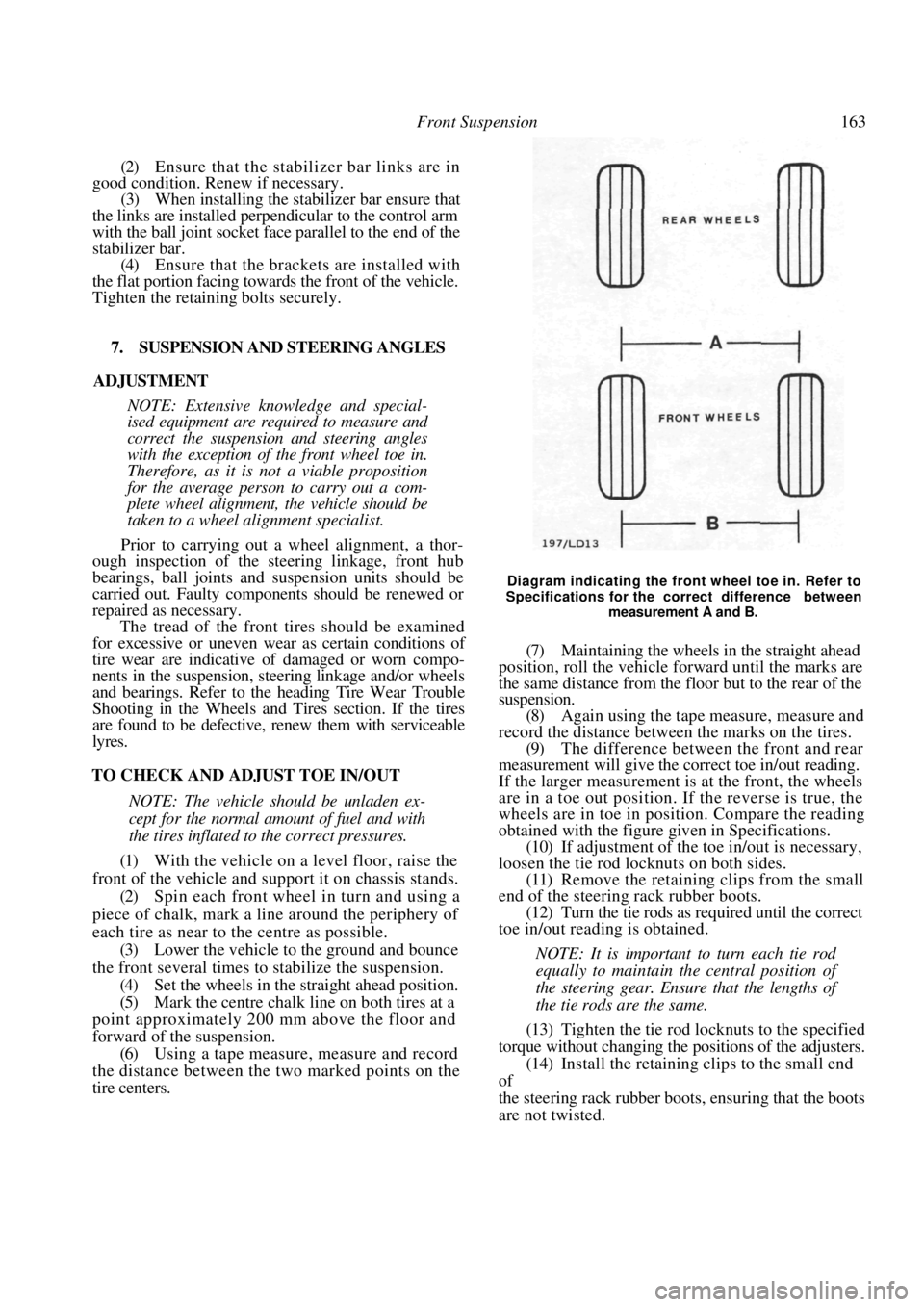
Front Suspension 163
(2) Ensure that the stabilizer bar links are in
good condition. Renew if necessary.
(3) When installing the stabilizer bar ensure that
the links are installed perpendicular to the control arm
with the ball joint socket face parallel to the end of the
stabilizer bar. (4) Ensure that the brackets are installed with
the flat portion facing towards the front of the vehicle.
Tighten the retaining bolts securely.
7. SUSPENSION AND STEERING ANGLES
ADJUSTMENT
NOTE: Extensive knowledge and special-
ised equipment are required to measure and
correct the suspension and steering angles
with the exception of the front wheel toe in.
Therefore, as it is not a viable proposition
for the average person to carry out a com-
plete wheel alignment, the vehicle should be
taken to a wheel alignment specialist.
Prior to carrying out a wheel alignment, a thor-
ough inspection of the steering linkage, front hub
bearings, ball joints and suspension units should be
carried out. Faulty components should be renewed or
repaired as necessary.
The tread of the front ti res should be examined
for excessive or uneven wear as certain conditions of
tire wear are indicative of damaged or worn compo-
nents in the suspension, stee ring linkage and/or wheels
and bearings. Refer to the heading Tire Wear Trouble
Shooting in the Wheels and Tires section. If the tires
are found to be defective, renew them with serviceable
lyres.
TO CHECK AND ADJUST TOE IN/OUT
NOTE: The vehicle s hould be unladen ex-
cept for the normal amount of fuel and with
the tires inflated to the correct pressures.
(1) With the vehicle on a level floor, raise the
front of the vehicle and s upport it on chassis stands.
(2) Spin each front wheel in turn and using a
piece of chalk, mark a line around the periphery of
each tire as near to the centre as possible. (3) Lower the vehicle to the ground and bounce
the front several times to stabilize the suspension. (4) Set the wheels in the straight ahead position.
(5) Mark the centre chalk line on both tires at a
point approximately 200 mm above the floor and
forward of the suspension. (6) Using a tape measure, measure and record
the distance between the two marked points on the
tire centers.
Diagram indicating the front wheel toe in. Refer to
Specifications for the correct difference between
measurement A and B.
(7) Maintaining the wheels in the straight ahead
position, roll the vehicle forward until the marks are
the same distance from the floor but to the rear of the
suspension. (8) Again using the tape measure, measure and
record the distance between the marks on the tires.
(9) The difference between the front and rear
measurement will give the correct toe in/out reading.
If the larger measurement is at the front, the wheels
are in a toe out position. If the reverse is true, the
wheels are in toe in position. Compare the reading
obtained with the figure given in Specifications.
(10) If adjustment of the to e in/out is necessary,
loosen the tie rod locknuts on both sides. (11) Remove the retaining clips from the small
end of the steering rack rubber boots. (12) Turn the tie rods as required until the correct
toe in/out reading is obtained.
NOTE: It is important to turn each tie rod
equally to maintain the central position of
the steering gear. Ensure that the lengths of
the tie rods are the same.
(13) Tighten the tie rod locknuts to the specified
torque without changing the positions of the adjusters.
(14) Install the retaining clips to the small end
of
the steering rack rubber boots, ensuring that the boots
are not twisted.
Page 177 of 238

Brakes 177
installed. Install the second back up ring, large
diam-
eter first.
(6) Install the second garter spring. Insert
a
machined drift into the bore and lightly push the
garter spring into its locating groove.
(7) Smear the secondary piston with clean brake
fluid. Ease the seal over the piston body into the
groove adjacent to the spring, ensuring that the seal lip
faces the spring and that the nylon spacer is against
the back of the seal. (8) Install the guide onto the secondary
piston,
large internal diameter first, followed by the main seal
with the lip facing away from the spring. (9) Lubricate the secondary piston assembly
with clean brake fluid and install the secondary spring
and retainer to the piston. Install the complete assem-
bly into the master cylinder bore. (10) Smear the primary piston with clean brake
fluid. Install the guide, large internal diameter first,
followed by the main seal with the lip facing towards
the small end of the piston.
(11) Install the retainer to the spigot on the front
end of the primary piston ensuring that the legs of the
retainer engage with the groove on the piston. (12) Lubricate the primary piston assembly with
clean brake fluid and install the assembly into the
master cylinder bore. With a blunt rod, push the
assembly down the bore sufficiently to preload the
pistons. While holding the preload, install the stop pin
and valve assemblies into
the master cylinder body and tighten securely. (13) Install a new O ring to the groove on the boss
of the mounting flange of the master cylinder.
(14) Install new O rings to th e pressure differential
pistons, smear them with cl ean brake fluid and install
them into the master cylinder body. (15) Install a new O ring to the pressure differen-
tial end plug, install the plug to the master
cylinder
body and tighten to the specified torque. (16) Using a blunt probe entered through the
sensing switch location hole, separate the pressure
differential pistons and install the switch actuating
lever between them. (17) Screw the sensing switch into its locating
hole until the detents on the switch body just contact
the locating hole facing (w ith the radial grooves).
Screw the switch assembly in a further half to one full
turn ensuring that the dete nts locate in the grooves.
(18) Install new valve seal s to the proportioning
valve plungers, with the serrations of the seals facing
away from the hexagons of the plungers.
(19) Install the new O rings to the
proportioning
valve plugs. (20) Install the valve springs over the stems of the
proportioning valves, insert the install the valve
plugs.
Tighten the plugs to the specified torque.
(21) Install a new O ring to the base of the fast fill
valve assembly. Install a new valve washer to the base
of the valve.
(22) Install the fast fill valve assembly in
the
primary reservoir port (nearest to the mounting flange
of the master cylinder) and install the snap ring
to
retain the assembly. Ensure that the snap ring is
correctly seated in the groove. (23) Smear the new reservoir retainers with clean
brake fluid and install them into the reservoir ports.
Carefully press the brake fluid reservoir into position,
ensuring that the outlet extensions are fully inserted in
the reservoir retainers. (24) Install the reservoir cap insert to the dia-
phragm and press the cap assembly onto the reservoir.
TO INSTAL
Installation is a reversal of the removal procedure
with attention to the following points:
(1) Pour a small amount of clean brake fluid into
the reservoir and pump the master cylinder pistons
with a blunt rod until fluid begins to emerge from the
outlets. (2) Install the master cylinder to the brake servo
unit and loosely install the master cylinder retaining
nuts. (3) Connect the brake pipes to the master cylin-
der outlets, but do not tighten at this stage. (4) Securely tighten the nuts retaining the master
cylinder to the brake servo unit.
(5) Securely tighten the brake pipes and connect
the wiring to the pressure sensing switch.
(6) Fill the master cylinder reservoir with clean
brake fluid and bleed the brakes as described under
the Hydraulic System heading. (7) Check and if necessary adjust the brake
pedal height and free play as described under the
Brake Pedal heading.
4. BRAKE SERVO UNIT
TO CHECK OPERATION
(1) With the engine switched off, apply the
footbrake several times to exhaust all vacuum from
the system.
(2) Apply the footbrake and hold the brake pedal
fully depressed.
(3) Start the engine. If the servo unit is function-
ing satisfactorily a distinct downward movement of
the
brake pedal should be noticed. Should the pedal fail to move downward when the
engine has been started, the vacuum system can be
considered inoperative.
NOTE: If the pedal continues to fall away
there is a fault in the hydraulic system.
(4) Ensure that the brake pedal is fully released,
start the engine and run it at medium speed. Stop the
engine.
Page 180 of 238
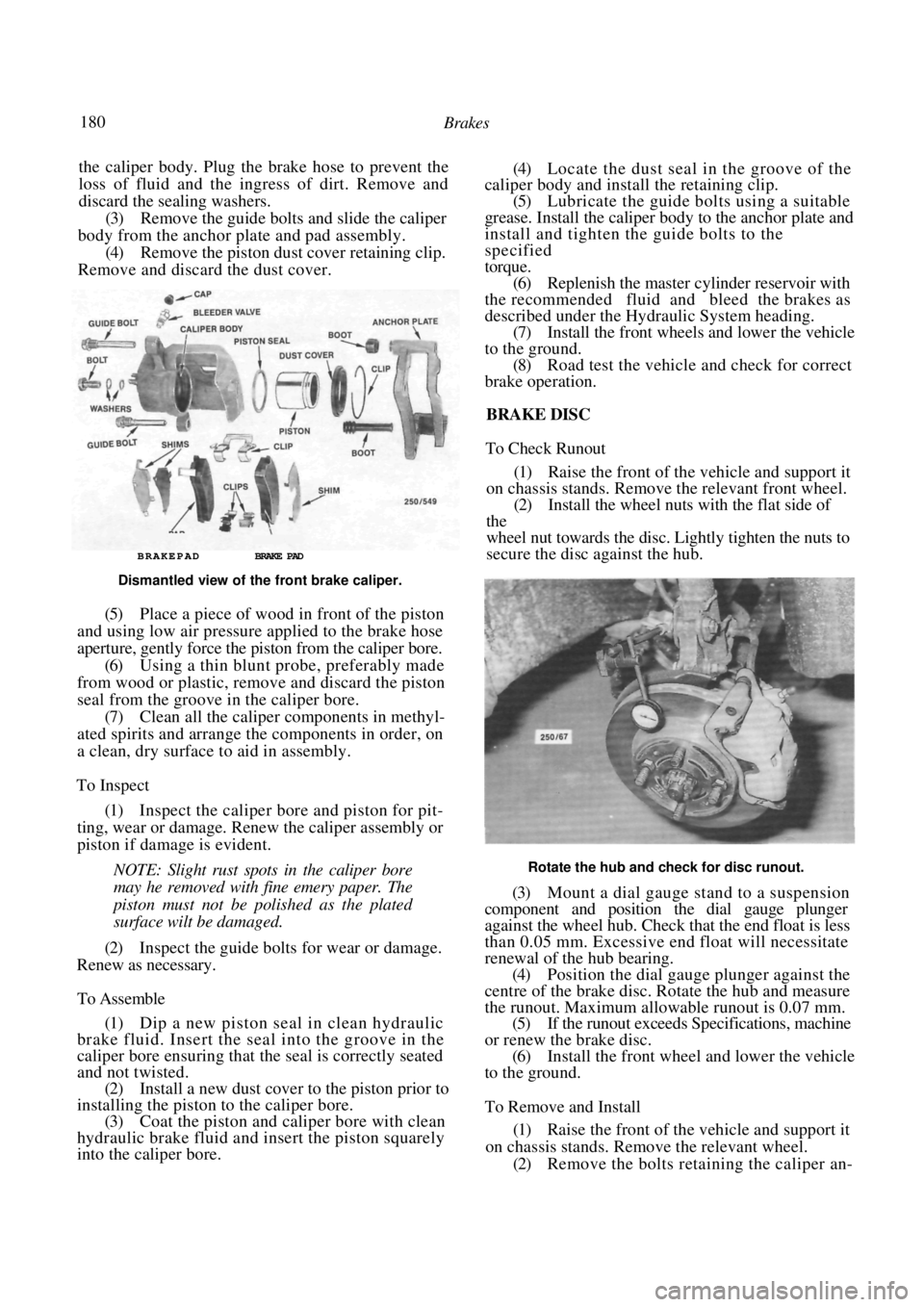
180 Brakes
the caliper body. Plug the brake hose to prevent the
loss of fluid and the ingress of dirt. Remove and
discard the sealing washers.
(3) Remove the guide bolts and slide the caliper
body from the anchor plate and pad assembly. (4) Remove the piston dust cover retaining clip.
Remove and discard the dust cover.
BRAKEPAD BRAKE PAD
Dismantled view of the front brake caliper.
(5) Place a piece of wood in front of the piston
and using low air pressure applied to the brake hose
aperture, gently force the piston from the caliper bore.
(6) Using a thin blunt probe, preferably made
from wood or plastic, remove and discard the piston
seal from the groove in the caliper bore. (7) Clean all the caliper components in methyl-
ated spirits and arrange the components in order, on
a clean, dry surface to aid in assembly.
To Inspect
(1) Inspect the caliper bore and piston for pit-
ting, wear or damage. Renew the caliper assembly or
piston if damage is evident.
NOTE: Slight rust spots in the caliper bore
may he removed with fine emery paper. The
piston must not be polished as the plated
surface wilt be damaged.
(2) Inspect the guide bolts for wear or damage.
Renew as necessary.
To Assemble
(1) Dip a new piston seal in clean hydraulic
brake fluid. Insert the seal into the groove in the
caliper bore ensuring that the seal is correctly seated
and not twisted.
(2) Install a new dust cover to the piston prior to
installing the piston to the caliper bore. (3) Coat the piston and caliper bore with clean
hydraulic brake fluid and insert the piston squarely
into the caliper bore.
(4) Locate the dust seal in the groove of the
caliper body and install the retaining clip.
(5) Lubricate the guide bolts using a suitable
grease. Install the caliper body to the anchor plate and
install and tighten the guide bolts to the
specified
torque. (6) Replenish the master cylinder reservoir with
the recommended fluid and bleed the brakes as
described under the Hydr aulic System heading.
(7) Install the front wheels and lower the vehicle
to the ground. (8) Road test the vehicle and check for correct
brake operation.
BRAKE DISC
To Check Runout
(1) Raise the front of the vehicle and support it
on chassis stands. Remove the relevant front wheel. (2) Install the wheel nuts with the flat side of
the
wheel nut towards the disc. Lightly tighten the nuts to
secure the disc against the hub.
Rotate the hub and check for disc runout.
(3) Mount a dial gauge stand to a suspension
component and position the dial gauge plunger
against the wheel hub. Check that the end float is less
than 0.05 mm. Excessive e nd float will necessitate
renewal of the hub bearing. (4) Position the dial gauge plunger against the
centre of the brake disc. Ro tate the hub and measure
the runout. Maximum allowable runout is 0.07 mm. (5) If the runout exceeds Specifications, machine
or renew the brake disc. (6) Install the fron t wheel and lower the vehicle
to the ground.
To Remove and Install
(1) Raise the front of the vehicle and support it
on chassis stands. Remove the relevant wheel. (2) Remove the bolts retaining the caliper an-
Page 185 of 238
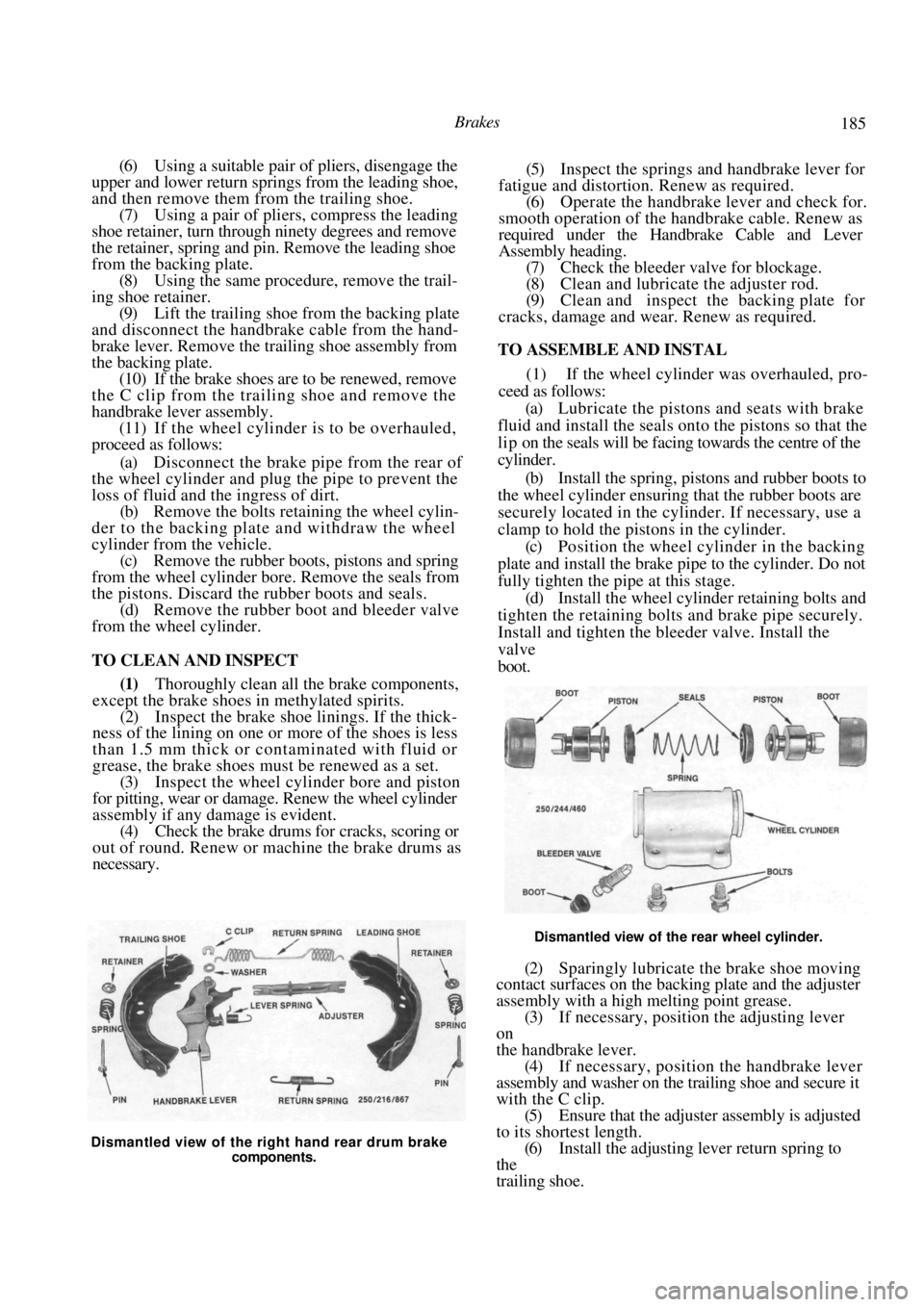
Brakes 185
(6) Using a suitable pair of pliers, disengage the
upper and lower return springs from the leading shoe,
and then remove them from the trailing shoe. (7) Using a pair of pliers, compress the leading
shoe retainer, turn through ninety degrees and remove
the retainer, spring and pin. Remove the leading shoe
from the backing plate. (8) Using the same procedure, remove the trail-
ing shoe retainer. (9) Lift the trailing shoe from the backing plate
and disconnect the handbrake cable from the hand-
brake lever. Remove the trailing shoe assembly from
the backing plate.
(10) If the brake shoes are to be renewed, remove
the C clip from the trailing shoe and remove the
handbrake lever assembly. (11) If the wheel cylinder is to be overhauled,
proceed as follows:
(a) Disconnect the brake pipe from the rear of
the wheel cylinder and plug the pipe to prevent the
loss of fluid and the ingress of dirt. (b) Remove the bolts retaining the wheel cylin-
der to the backing plate and withdraw the wheel
cylinder from the vehicle. (c) Remove the rubber boots, pistons and spring
from the wheel cylinder bore. Remove the seals from
the pistons. Discard th e rubber boots and seals.
(d) Remove the rubber boot and bleeder valve
from the wheel cylinder.
TO CLEAN AND INSPECT
(1) Thoroughly clean all the brake components,
except the brake shoes in methylated spirits.
(2) Inspect the brake shoe linings. If the thick-
ness of the lining on one or more of the shoes is less
than 1.5 mm thick or contaminated with fluid or
grease, the brake shoes must be renewed as a set. (3) Inspect the wheel cylinder bore and piston
for pitting, wear or damage. Renew the wheel cylinder
assembly if any damage is evident. (4) Check the brake drums for cracks, scoring or
out of round. Renew or machine the brake drums as
necessary.
(5) Inspect the springs and handbrake lever for
fatigue and distortion. Renew as required. (6) Operate the handbrake lever and check for.
smooth operation of the handbrake cable. Renew as
required under the Hand brake Cable and Lever
Assembly heading. (7) Check the bleeder valve for blockage.
(8) Clean and lubricate the adjuster rod.
(9) Clean and inspect the backing plate for
cracks, damage and wear. Renew as required.
TO ASSEMBLE AND INSTAL
(1) If the wheel cylinder was overhauled, pro-
ceed as follows:
(a) Lubricate the pistons and seats with brake
fluid and install the seals on to the pistons so that the
l i p on the seals will be facing towards the centre of the
cylinder.
(b) Install the spring, pistons and rubber boots to
the wheel cylinder ensuring that the rubber boots are
securely located in the cy linder. If necessary, use a
clamp to hold the pistons in the cylinder.
(c) Position the wheel cylinder in the backing
plate and install the brake pi pe to the cylinder. Do not
fully tighten the pipe at this stage. (d) Install the wheel cylinder retaining bolts and
tighten the retaining bolts and brake pipe securely.
Install and tighten the bleeder valve. Install the
valve
boot.
Dismantled view of the right hand rear drum brake
components. Dismantled view of the rear wheel cylinder.
(2) Sparingly lubricate the brake shoe moving
contact surfaces on the backing plate and the adjuster
assembly with a high melting point grease.
(3) If necessary, position the adjusting lever
on
the handbrake lever. (4) If necessary, position the handbrake lever
assembly and washer on the trailing shoe and secure it
with the C clip.
(5) Ensure that the adjuster assembly is adjusted
to its shortest length. (6) Install the adjusting lever return spring to
the
trailing shoe.
Page 186 of 238

186 Brakes
(7) Using a pair of pliers, compress the hand-
brake cable spring and install the cable to the hand-
brake lever.
(8) Position the trailing shoe on the backing
plate with the upper end located on the wheel cylinder
piston and the lower end on the anchor plate. (9) Install the adjuster assembly to the
trailing
shoe ensuring that the adjuster fork is correctly
located on the upper end of the shoe. (10) Install the pin, spring and retainer to the
trailing shoe, turn the reta iner through 90 degrees and
secure the brake shoe to the backing plate. (11) Connect the upper and lower return springs
to the trailing shoe as noted on removal. (12) Position the leading shoe on the backing
plate with the upper end located on the wheel cylinder
piston and the lower end on the anchor plate. Ensure
that the adjuster assembly is correctly located on the
upper end of the shoe. (13) Install the pin, spring and retainer to the
leading shoe, turn the retainer through 90 degrees and
secure the shoe to the backing plate. (14) Connect the upper and lower return springs
to the leading shoe.
(15) By alternatively adjust ing the automatic ad-
juster manually and sliding the brake drum on and off
the brake shoe assembly, adjust the brakes until the
brake drum will just slide over the brake shoes. Ensure
that the adjuster lever contacts the adjuster star wheel.
Install the brake drum and operate the handbrake
several times to adjust the brake shoes. (16) Install the rear wheels and rotate each wheel
to ensure that the brake shoe linings are not dragging.
(17) Bleed the hydraulic system as described
under the Hydraulic System heading. (18) Adjust the handbrake as described under the
Brake Adjustments heading.
8. HANDBRAKE CABLE AND LEVER
ASSEMBLY
HANDBRAKE LEVER AND FRONT CABLE
ASSEMBLY
To Remove and Install
(1) Raise the vehicle and support it on chassis
stands. Release the handbrake.
(2) Working beneath the vehicle, remove the
exhaust pipe centre heat shield retaining bolts and
maneuver the shield from the vehicle. (3) Remove the rear handbrake cable front
clamp retaining nuts and disconnect the rear hand-
brake cable from the equalizer. (4) Working within the vehicle, remove the
carpet square from the rear of the console. Remove
the retaining screw from the front and rear of the rear
console section and maneuver the rear console from
the vehicle.
Dismantled view of the handbrake lever components.
(5) Disconnect the handbrake warning lamp
switch wiring. (6) Remove the handbrake lever assembly re-
taining bolts and remove the handbrake lever and
front cable assembly. (7) If necessary slide the boot and cover towards
the equalizer, straighten the tang on the lower edge of
the lever and remove the adjuster nut and washer.
(8) Withdraw the front cable from the lever and
remove the boot and cover. Inspect the cable for
chafing or broken strands. Renew the cable if damage
is evident. (9) Check the handbrake lever ratchet and pawl
for wear and renew as necessary. Installation is a reversal of the removal procedure
with attention to the following points:
(1) Apply lubricant to all the working parts prior
to installation. (2) Ensure that the handbrake cable clamp is
correctly installed. (3) Adjust the handbrake cable as described
under the Brake Adjustments heading.
REAR HANDBRAKE CABLES
TO Remove and Install
(1) Raise the rear of the vehicle and support it
on chassis stands. Remove th e rear wheels and release
the handbrake.
(2) Working beneath the vehicle, remove the
exhaust pipe centre and rear heat shield retaining
bolts and maneuver the heat shields from the
vehicle.
(3) Remove the bolts and nuts retaining the
handbrake cable clamps to the underbody and discon-
nect the rear handbrake cable from the equalizer.
(4) On disc brake models, remove the handbrake
cable to bracket retaining clip on the rear of the
caliper and disconnect the handbrake cable from the
cam lever. Remove the cable from the vehicle.
(5) On drum brake models , proceed as follows:
(a) Remove and dismantle the rear brakes as
previously described.
Page 194 of 238
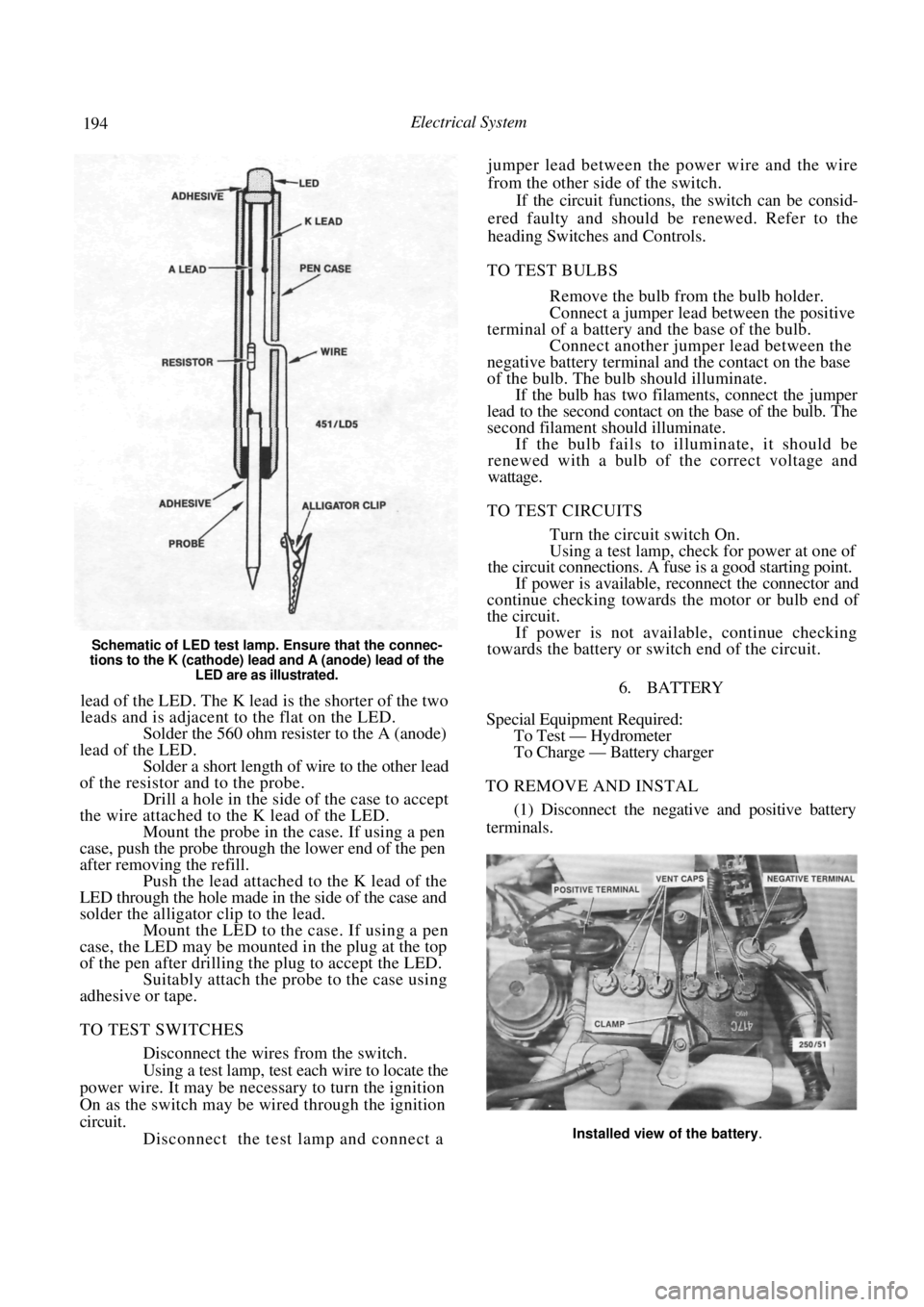
194 Electrical System
Schematic of LED test lamp. Ensure that the connec-
tions to the K (cathode) lead and A (anode) lead of the LED are as illustrated.
lead of the LED. The K lead is the shorter of the two
leads and is adjacent to the flat on the LED.
Solder the 560 ohm resister to the A (anode)
lead of the LED. Solder a short length of wire to the other lead
of the resistor and to the probe. Drill a hole in the side of the case to accept
the wire attached to the K lead of the LED. Mount the probe in the case. If using a pen
case, push the probe through the lower end of the pen
after removing the refill. Push the lead attached to the K lead of the
LED through the hole made in the side of the case and
solder the alligator clip to the lead.
Mount the LED to the case. If using a pen
case, the LED may be mounted in the plug at the top
of the pen after drilling the plug to accept the LED. Suitably attach the probe to the case using
adhesive or tape.
TO TEST SWITCHES
Disconnect the wires from the switch.
Using a test lamp, test each wire to locate the
power wire. It may be nec essary to turn the ignition
On as the switch may be wired through the ignition
circuit. Disconnect the test lamp and connect a jumper lead between the power wire and the wire
from the other side of the switch.
If the circuit functions, the switch can be consid-
ered faulty and should be renewed. Refer to the
heading Switches and Controls.
TO TEST BULBS
Remove the bulb from the bulb holder.
Connect a jumper lead between the positive
terminal of a battery a nd the base of the bulb.
Connect another jumper lead between the
negative battery terminal and the contact on the base
of the bulb. The bulb should illuminate. If the bulb has two filaments, connect the jumper
lead to the second contact on the base of the bulb. The
second filament should illuminate.
If the bulb fails to illuminate, it should be
renewed with a bulb of the correct voltage and
wattage.
TO TEST CIRCUITS
Turn the circuit switch On.
Using a test lamp, check for power at one of
the circuit connections. A fuse is a good starting point.
If power is available, reconnect the connector and
continue checking towards the motor or bulb end of
the circuit.
If power is not available, continue checking
towards the battery or switch end of the circuit.
6. BATTERY
Special Equipment Required: To Test — Hydrometer
To Charge — Battery charger
TO REMOVE AND INSTAL
(1) Disconnect the negative and positive battery
terminals.
Installed view of the battery.